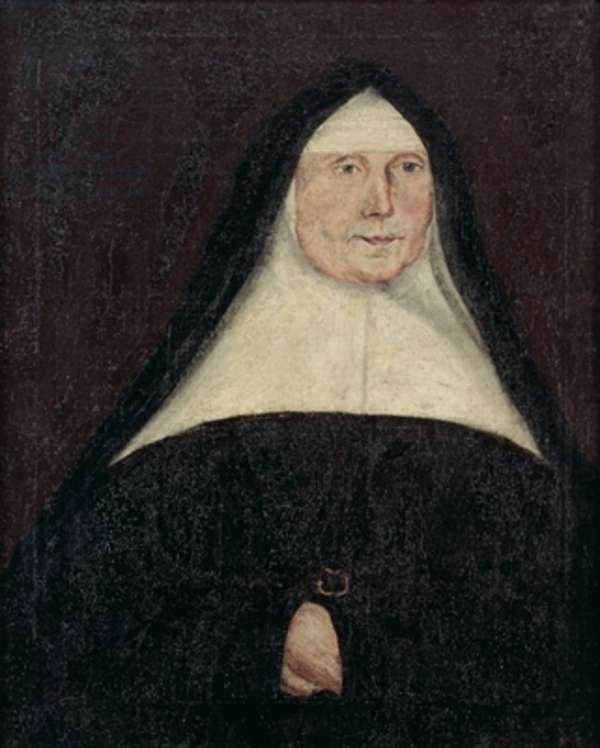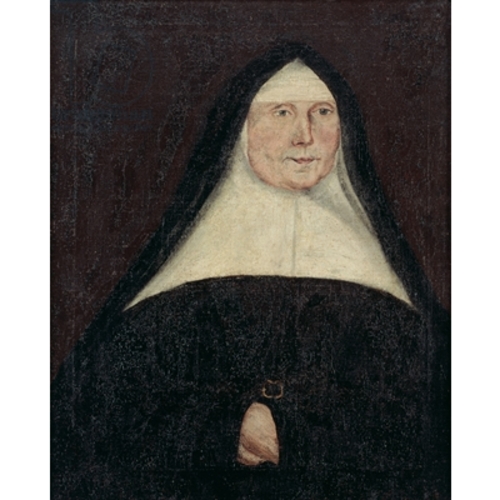
Source: Link
WHEELWRIGHT, ESTHER (rebaptized Marie-Joseph), dite de l’Enfant-Jésus, Ursuline and superior; b. 10 April 1696 (n.s.) at Wells, Massachusetts (now Maine), daughter of Colonel John Wheelwright and Mary Snell; d. 28 Nov. 1780 at Quebec.
Esther Wheelwright’s father, like her great-grandfather, the Reverend John Wheelwright, and her grandfather, Judge Samuel Wheelwright, was prominent in the town of Wells. On 14 June 1701 Esther was baptized in the local Congregationalist church.
On 21 Aug. 1703 several hundred Abenakis and some Canadians led by Alexandre Leneuf* de La Vallière et de Beaubassin ravaged Wells and nearby frontier settlements. Esther was carried off by the Abenakis to the forests between the Kennebec and Androscoggin rivers. There she was instructed in the Catholic religion by French missionaries, who rebaptized her conditionally and rechristened her Marie-Joseph. Her parents, having learned of her whereabouts, used the authority of the government of Massachusetts Bay to petition Governor Philippe de Rigaud* de Vaudreuil to obtain her release. He sent a Jesuit much revered by the Abenakis, Father Vincent Bigot*, who after some delicate negotiations persuaded the Indians to release the girl. They did so as a compliment to Vaudreuil and in exchange for a captive Indian boy sent by Esther’s father from Boston to Quebec.
Late in 1708 Father Bigot brought Esther to Quebec, where she was treated by Vaudreuil with special consideration as the “daughter of the governor of a small place,” a misconception arising, apparently, from the reports of Colonel Wheelwright’s influence in Wells and of his position as a member of Governor Joseph Dudley’s council. Wartime conditions made it difficult, however, to send Esther home immediately, and on 18 Jan. 1709 she was placed in the Ursuline boarding school.
After 18 months as a pupil, she asked to become a nun. Influenced by Father Bigot, who offered to pay the expenses of her entry with money sent from France, the Ursulines agreed to accept her. Vaudreuil objected, however, because he felt obligated to return her to her family. He withdrew her from the Ursulines in the autumn of 1710, and she spent the following winter at Château Saint-Louis, the governor’s residence in Quebec. In June 1711, after receiving from Boston another demand for her release, Vaudreuil brought her to Montreal, whence he intended to send her home. Further difficulties, coupled with her own reluctance, kept him from doing so. For several months she lived at the Hôtel-Dieu, making the acquaintance of the English captives in the city, among them her cousin, Esther Sayward, and Mary Silver*. The two cousins remained friends until Esther Sayward’s death in 1770. In Montreal Esther also met the zealous Sulpician, Father Henri-Antoine Meriel*, who exerted much influence on the captives. He arranged for her to stand sponsor with Nicolas Lemoyne d’Assigny at the baptism on 3 Oct. 1711 of Dorothée de Noyon, whose mother was Marguerite de Noyon [Abigail Stebbins] of Deerfield, Massachusetts.
Esther was next taken to Trois-Rivières, where the Ursulines were eager to receive her into their nascent community. She preferred the Ursulines of Quebec, however, and began her postulancy with them on 2 Oct. 1712. She took the habit as Esther-Marie-Joseph de l’Enfant-Jésus on 3 Jan. 1713. On this occasion Father Bigot preached a moving sermon, the manuscript of which contains what little is known of Esther’s life among the Abenakis.
Esther de l’Enfant-Jésus had concluded little more than half of her noviciate when in 1714, after the signing of the treaty of Utrecht, her family again sought her return. In compliance with her earnest plea, Bishop Saint-Vallier [La Croix*] advanced the time of her profession of vows to 12 April 1714, thus ensuring that she would remain in Canada. Contact between Esther and her family was maintained through occasional visits by nephews from New England. Both her father and mother left her bequests, conditional upon her return from Canada, and gifts were exchanged.
Anxious to consolidate the good relations established with the British during 1759 and 1760, when they had acted as nurses for the British troops and Esther had been assistant superior, the Ursulines elected her superior on 15 Dec. 1760. The serene strength which made her respected in the community also made her a logical choice to govern it. She did so from 1760 to 1766, and from 1769 to 1772. She served again as assistant superior from 1772 to 1778, and as zelatrice from 1778 until her death in 1780.
Through a policy of flexibility Esther maintained good relations between the Ursulines and the British authorities. She re-established, though with difficulty, the community’s affairs in France and placed it on firm ground financially by encouraging the nuns to perfect their skill in birch-bark embroidery, which became a highly profitable enterprise. The reopening of the noviciate in 1764 after a lapse of nine years had guaranteed the continuing existence of the community, which Esther de l’Enfant-Jésus had helped to restore and direct during 20 of the most difficult years of its history.
AN, Col., B, 34/1, p.113 (PAC transcript); C11A, 30, ff.422–30; 32, ff.119–23, 156–58; 33, ff.15–37, 249–53; 34, ff.333–42. ANQ-M, État civil, Catholiques, Notre-Dame de Montréal, 3 oct. 1711. AUQ, Actes d’élections des supérieures, 63, 67–69; Actes des assemblées capitulaires, 1, pp. 111, 123–24, 127, 275–78, 298, 328; Actes de professions et de sépultures, 1, pp.70–71; Annales, I, pp.127–28, 216, 254, 259, 268, 277, 301, 331; Conclusions des assemblées des discrètes, 1, pp.54–55; Corr. des laïcs, Corr. de Miss C. A. Baker avec mère Sainte-Croix; Lettres, pétitions, gouverneurs anglais, juin 1761, 6 mars 1762, 2 janv. 1764, 23 avril 1767; Corr. des ursulines de Paris, 28 sept. 1747, 6 mai 1761, 31 août 1771, 20 sept. 1772, 22 août 1789; Fonds de la famille Wheelwright; Fonds dots des religieuses; Fonds sermons, Sermon du R. P. Vincent Bigot, s.j., 3 janv. 1713; Journal, 2; Livre des entrées et sorties des filles françaises et sauvages; Registre de l’examen canonique des novices, 1, pp.37–38; Registre des entrées, vêtures, professions et décès des religieuses, 1, p.11. Mass. Hist. Soc., Wheelwright family papers; A journal of the proceedings of Nathaniel Wheelwright appointed and commission’d by his Excellency William Shirley Esquire Governour and Commander in Chief in and over His Majestys Province of the Massachusetts Bay in New England from Boston to Canada in order to redeem the captives belonging to this Government in the hands of the French and Indians. Pocumtuck Valley Memorial Assoc. (Deerfield, Mass.), Papers of C. A. Baker. Coll. de manuscrits relatifs à la N.-F., II, 506. Maine wills, 1640–1760, ed. W. M. Sargent (Portland, Maine, 1887), 522–26, 769–72. Genealogical dictionary of Maine and New Hampshire, comp. Sybil Noyes et al. (Portland, Maine, 1928–39). C. A. Baker, True stories of New England captives carried to Canada during the old French and Indian wars (Cambridge, Mass., 1897). E. E. Bourne, The history of Wells and Kennebunk from the earliest settlement to the year 1820, at which time Kennebunk was set off, and incorporated, with biographical sketches (Portland, Maine, 1875). Coleman, New England captives. M. Trudel, L’Église canadienne.
Cite This Article
Gerald M. Kelly, “WHEELWRIGHT, ESTHER (rebaptized Marie-Joseph), dite de l’Enfant-Jésus,” in Dictionary of Canadian Biography, vol. 4, University of Toronto/Université Laval, 2003–, accessed December 31, 2025, https://www.biographi.ca/en/bio/wheelwright_esther_4E.html.
The citation above shows the format for footnotes and endnotes according to the Chicago manual of style (16th edition). Information to be used in other citation formats:
| Permalink: | https://www.biographi.ca/en/bio/wheelwright_esther_4E.html |
| Author of Article: | Gerald M. Kelly |
| Title of Article: | WHEELWRIGHT, ESTHER (rebaptized Marie-Joseph), dite de l’Enfant-Jésus |
| Publication Name: | Dictionary of Canadian Biography, vol. 4 |
| Publisher: | University of Toronto/Université Laval |
| Year of publication: | 1979 |
| Year of revision: | 1979 |
| Access Date: | December 31, 2025 |



